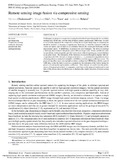- CERES Home
- →
- Cranfield Defence and Security
- →
- Staff publications (CDS)
- →
- View Item
JavaScript is disabled for your browser. Some features of this site may not work without it.
| dc.contributor.author | Ghahremani, Morteza | |
| dc.contributor.author | Liu, Yonghuai | |
| dc.contributor.author | Yuen, Peter W. T. | |
| dc.contributor.author | Behera, Ardhendu | |
| dc.date.accessioned | 2019-04-15T13:08:36Z | |
| dc.date.available | 2019-04-15T13:08:36Z | |
| dc.date.issued | 2019-04-05 | |
| dc.identifier.citation | Ghahremani M, Liu Y, Yuen P, Behera A. Remote sensing image fusion via compressive sensing. ISPRS Journal of Photogrammetry and Remote Sensing, Volume 152, June 2019, pp. 34-48 | en_UK |
| dc.identifier.issn | 0924-2716 | |
| dc.identifier.uri | https://doi.org/10.1016/j.isprsjprs.2019.04.001 | |
| dc.identifier.uri | http://dspace.lib.cranfield.ac.uk/handle/1826/14083 | |
| dc.description.abstract | In this paper, we propose a compressive sensing-based method to pan-sharpen the low-resolution multispectral (LRM) data, with the help of high-resolution panchromatic (HRP) data. In order to successfully implement the compressive sensing theory in pan-sharpening, two requirements should be satisfied: (i) forming a comprehensive dictionary in which the estimated coefficient vectors are sparse; and (ii) there is no correlation between the constructed dictionary and the measurement matrix. To fulfill these, we propose two novel strategies. The first is to construct a dictionary that is trained with patches across different image scales. Patches at different scales or equivalently multiscale patches provide texture atoms without requiring any external database or any prior atoms. The redundancy of the dictionary is removed through K-singular value decomposition (K-SVD). Second, we design an iterative l1-l2 minimization algorithm based on alternating direction method of multipliers (ADMM) to seek the sparse coefficient vectors. The proposed algorithm stacks missing high-resolution multispectral (HRM) data with the captured LRM data, so that the latter is used as a constraint for the estimation of the former during the process of seeking the representation coefficients. Three datasets are used to test the performance of the proposed method. A comparative study between the proposed method and several state-of-the-art ones shows its effectiveness in dealing with complex structures of remote sensing imagery. | en_UK |
| dc.language.iso | en | en_UK |
| dc.publisher | Elsevier | en_UK |
| dc.rights | Attribution-NonCommercial 4.0 International | * |
| dc.rights.uri | http://creativecommons.org/licenses/by-nc/4.0/ | * |
| dc.subject | Pan-sharpening | en_UK |
| dc.subject | Compressive sensing | en_UK |
| dc.subject | Multiscale dictionary | en_UK |
| dc.subject | Panchromatic data | en_UK |
| dc.subject | Multispectral data | en_UK |
| dc.title | Remote sensing image fusion via compressive sensing | en_UK |
| dc.type | Article | en_UK |
| dc.identifier.cris | 23349914 |
Files in this item
The following license files are associated with this item:
This item appears in the following Collection(s)
-
Staff publications (CDS) [1209]

